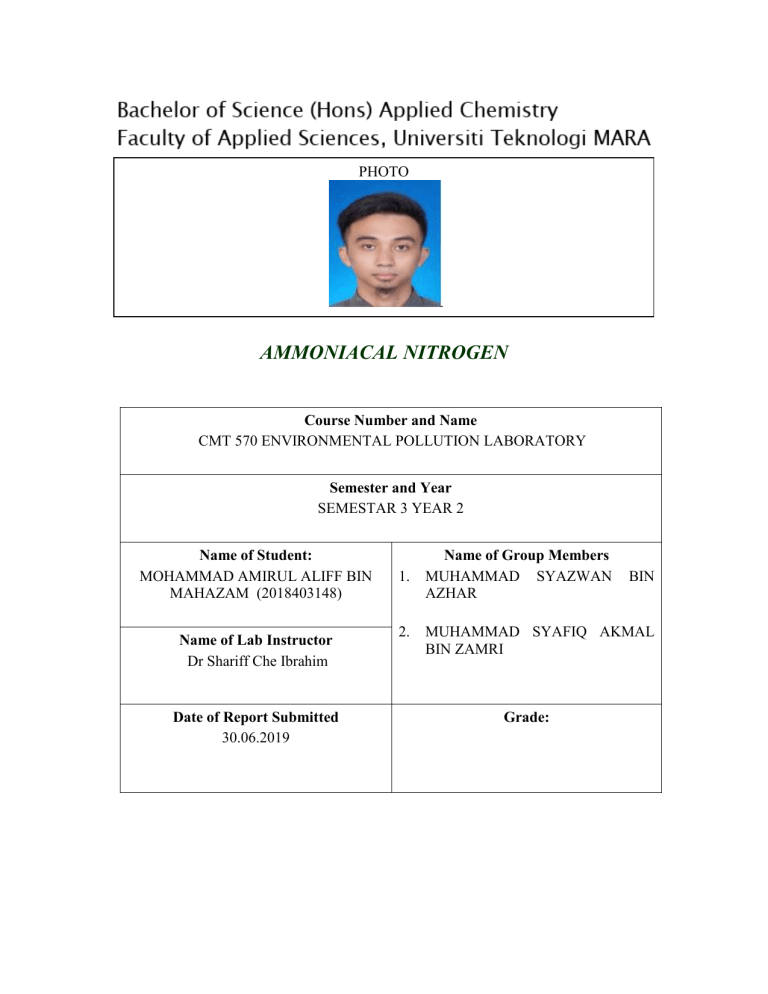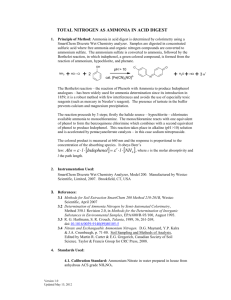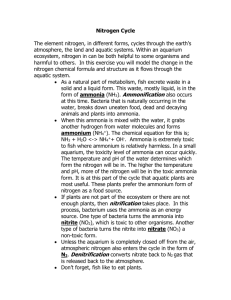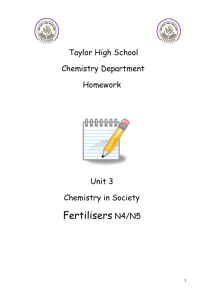
PHOTO AMMONIACAL NITROGEN Course Number and Name CMT 570 ENVIRONMENTAL POLLUTION LABORATORY Semester and Year SEMESTAR 3 YEAR 2 Name of Student: MOHAMMAD AMIRUL ALIFF BIN MAHAZAM (2018403148) Name of Lab Instructor Dr Shariff Che Ibrahim Date of Report Submitted 30.06.2019 1. 2. Name of Group Members MUHAMMAD SYAZWAN AZHAR BIN MUHAMMAD SYAFIQ AKMAL BIN ZAMRI Grade: 1. ABSTRACT Ammoniacal nitrogen (NH3) in the experiment, is the determination for the concentration of ammonia, a toxic pollutants in the given water sample. The measurement of ammonia and ammonium levels in water is a commonly measured parameter in environmental water, potable water and waste water. The determination is so vital because, ammonia is found naturally in water, but if it is found at higher than natural levels this is a sign of contamination. Ammonia levels higher than around 0.1 mg/L usually indicate polluted waters. Ammonia is colourless and odourless in small amounts, so the only way to detect it is through ammonia testing. This is particularly vital in fisheries as, although fish naturally excrete ammonia, an accumulation can harm fish. Early detection allows for the elimination of ammonia before the concentration reaches toxic levels. The determination of ammoniacal nitrogen can be done through APHA 4500-NH3 B & E 20TH Edition, 1998 (Titrimetric method) which is preliminary distillation step and ammonia-selective electrode method using known addition. The diluted sample is buffered at pH 9.5 with a borate buffer. After that, the sample undergoes distillation and the distillation product will be titrated with standard sulphuric acid, 0.02N with the end point appearance of purple-blue color. From titration, the result was 47.43 mL. Hence the ammoniac nitrogen of the sample was successfully obtained at 131.66 mg/L. The result when compare to the National water quality standard was high and was under category of V water class. 1 2. OBJECTIVE AND INTRODUCTION 2.1.OBJECTIVE To determine the ammoniacal nitrogen in the given water sample through titrimetric method. To compare the result obtained with standard water 2.2.INTRODUCTION Ammonia is toxic to fish and humans. Ammonia is used in fertilizer and animal feed production as well as in the manufacture of plastics, paper, rubber, etc. The levels of ammonium /ammonia in environmental waters has been affected improper disposal from these industries. As for concern the major contributor of ammonia concentration comes from agricultural runoff, sewage effluent, landfill leachate and industrial effluent. Ammonia is toxic to fish and other aquatic organisms, even in very low concentrations. The higher the pH and the warmer the water, the more toxic the ammonia. In addition to the actual ammonia in the water being toxic to aquatic life, it can also cause eutrophication in a water body promoting the growth of choking aquatic vegetation or algal blooms that disrupt the normal functioning of the ecosystem and reduce the amount of oxygen in the water, needed for fish and other aquatic life to survive Ammonia is colorless and odorless in small amounts, so the only way to detect it is through ammonia testing. Early detection allows for the elimination of ammonia before the concentration reaches toxic levels. This is why an ammonia water test is vital for these ecosystems. 2 3. THEORY AND EXPERIMENTAL METHODS 3.1.THEORY Ammoniacal nitrogen (NH3), is a measure for the amount of ammonia. Ammonia is highly soluble in water. Ammonia reacts with water (H2O) and forms the ionized form: The values of ammoniacal nitrogen in water or waste liquids are measured in milligram per liter. Usually the titrimetric method was in ammoniacal nitrogen analysis. The titrimetric method is used only on samples that have been carried through preliminary distillation. The sample is buffered at pH 9.5 with a borate buffer to decrease hydrolysis of cyanates and organic nitrogen compounds. At low pH, the interference (Amines) will be enhanced, reduce the accuracy of the experiments. While at high pH it will reduce interferences make the analysis more acceptable. The presence of NaOH solution will reduce the interferences by mercury and silver by complexing with ammonia. It is then distilled into a solution of boric acid when titration is to be used or into 𝐻2 𝑆𝑂4 . The ammonia in the distillate can be determined titrimetrically with standard 𝐻2 𝑆𝑂4 and a mixed indicator. 3 3.2.EXPERIMENTAL METHODS 3.2.1. Apparatus Electrical heating device, adjustable Distillation apparatus, consist of : A 1 litre round bottom flask, capacity: 300-500ml (24/29), made of Pyrex glass itted with a dropping funnel, multiple adapter, splash head, together with a suitable vertical condenser and a delivery adapter. 3.2.2. Reagents Borate buffer solution: Sodium Hydroxide, 6N NaOH: Absorbent solutions, plain boric acid: Mixed methyl red indicator: Phenolphthalein indicator Ammonium Chloride standard, 1000 ppm Sulphuric acid, 1N Sodium Hydroxide, 1N 3.2.3. Procedure Preparation of reagents a) Borate buffer solution 1. 88 ml of 0.1N NaOH solution was added to 500ml 0f 0.025M sodium tetraborate (𝑁𝑎2 𝐵4 𝑂7 ) solution and diluted to 1 liter. b) Sodium hydroxide, 6N NaOH 1. NaOH with mass of 240g was dissolved in 1 liter ammonia-free distilled water. c) Absorbent solutions, plain boric acid 4 1. 20g of 𝐻3 𝐵𝑂3 was dissolved in ammonia-free distilled water and diluted to 1 liter. d) Mixed methyl red indicator 1. 0.2g methyl red was dissolved in 100ml isopropyl alcohol. 2. 0.10g methylene blue was dissolved in 50ml isopropyl alcohol. 3. These two solutions were combine e) Ammonium Chloride standard, 1000 ppm 1. 3.819g of 𝑁𝐻4 𝐶𝑙 was dissolved in 1 liter distilled water. Sample preparation 1. Sample was measured to 1000 ml, added to the distillation flask and was diluted in 100ml deionized water. 2. Then, 25 ml of borate buffer was added to the solution. 3. pH of the solution was adjusted to pH=9.5 with 20 ml of 24% of NaOH using 3 drops of phenolphthalein indicator. Distillation 1. The prepared 5000ml conical receiving flask was added with 25ml of plain absorbent solution then 2-3 drops of mixed methyl red indicator was added for titrimetric method. The tip of delivery tube has been make sure was below the surface of the absorbent solution. Delivery adapter then was fitted to this flask. 2. The contents in the distillation flask was boiled for 2.50 minutes until about 200ml of distillate was collected in the receiver. 3. Excessive frothing has been avoided especially during the boiling of the mixture. 4. The distillate was immediately titrated with standard sulphuric acid, 0.02N (end point was when the appearance of purple-blue color was appeared). 5. Control blank was carried out follows the exact procedure by replacing sample with distilled water (in each batch of determination). 5 4. RESULTS AND DISCUSSION Ammoniacal nitrogen are important parameters that are used in water quality measurement. The presence of ammonia nitrogen can be seen in a water sample. In determination of ammoniacal nitrogen in the water sample we use the titrimetric method. In this water quality analysis, I had determined the ammoniacal nitrogen in given water sample and compare to the content limit. From experiment, the ammoniacal nitrogen (𝑁𝐻3 ), 𝑚𝑔/𝐿 has been obtained for sample, standard and blank. For blank solution it is 0 mg/L, while for standard it is 52.9 mg/L and for the sample it is 131.66 mg/L Ammoniacal Nitrogen (𝑁𝐻3 ), mg/L Blank solution 0 Standard solution 52.9 Sample 131.66 From the experiment, we found that the reading of sample that have recorded is 131.66 mg/L is more higher compared to the standard due to high concentration ammonia in that water sample. High concentration occurs in water polluted by sewage or some kinds of industrial wastes containing organic nitrogen or free water ammonium salts. When the value obtain was compared with National Water, the value was considered high and does not suitable for drinking purposes. Our sample in consist of high level of ammonia concentration, will harm the aquatic animal. The high concentration of ammonia in the water greater than 5 mg/L will cause excessive growth of algae and other plants, leading to accelerated eutrophication or 'aging' of lakes, and occasional loss of dissolved oxygen. Animals and humans cannot use inorganic forms of nitrogen, so nitrate is not a nutrient for us. 6 5. CONCLUSIONS In conclusion, using titrimetric method the ammoniacal nitrogen of the given sample has been obtained which is recorded at 131.66 mg/L. Then, the value was considered high when compare to National Water Quality Standard for Malaysia because exceeded >2.7mg/L and was categorized under V class of river water. 6. REFERENCES Standard Methods: 4500-NH3 B: Ammonia: Preliminary Distillation Step. Retrieved from https://www.nemi.gov/methods/method_summary/9887/ NEMI Method Summary - 4500-NH3 E. Retrieved from https://www.nemi.gov/methods/method_summary/7435/ Ammonium / Ammonia Water Test Meters & Probes From Aquaread. (2008). Retrieved from https://www.aquaread.com/need-help/what-are-you- measuring/ammonium-ammonia/ 7 7. APPENDICES A. Data Tables Blank solution Standard Sample Sample volume, mL Titration value, mL 100 mL distilled water 100 mL standard ammonium chloride,1000 ppm 100 mL sample solution 0.41 Ammoniacal nitrogen (𝑁𝐻3 ), 𝑚𝑔/𝐿 0 19.32 52.9 47.43 131.66 B. Sample Calculations Ammoniacal Nitrogen (mg/l) = (𝐴−𝐵) × 280 𝐶 A = volume of standard 𝐻2 𝑆𝑂4, 0.02N used in titrating sample, ml. B = volume of standard 𝐻2 𝑆𝑂4, 0.02N used in titrating blank, ml. C = volume of sample used (ml) Blank = (0.41−0.41)×280 100 = 0 𝑚𝑔/𝐿 Standard = (19.32−0.41)×280 100 = 52.9 𝑚𝑔/𝐿 Sample = (47.43−0.41)×280 100 = 131.66 𝑚𝑔/𝐿 8 C. National Water Quality Standard for Malaysia 9






